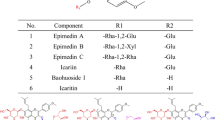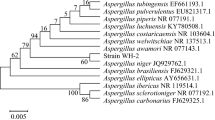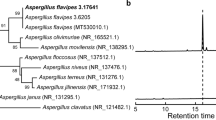Abstract
The objective of this work was to take advantage of the resting cells of suitable fungus as an in vitro model to prepare gastrodin from p-2-hydroxybenzyl alcohol (HBA), which mainly exists in the metabolites of the plant Gastrodia elata Blume. The one-step biotransformation of HBA into gastrodin was examined with the filamentous fungi cells of Aspergillus foetidus and Penicillium cyclopium AS 3.4513 in this study. The fundamental conditions of biotransformation were screened and compared for both fungi. P. cyclopium AS 3.4513 had better gastrodin-producing capability than A. foetidus through one-step bioconversion. The highest yield of gastrodin was 36 mg/L for A. foetidus ZU-G1 and 65 mg/L for P. cyclopium AS 3.4513 under the respective development condition during 6 days of biotransformation. The comparative results show that P. cyclopium AS 3.4513 reveals great potential to form gastrodin using HBA as the precursor. The products catalyzed by the resting cells of P. cyclopium AS 3.4513 were identified through NMR and ESI-MS. Current results can be applied not only to the chemical synthesis processes that may involve the hydroxylation reaction but also to the industrial production. The selected fungus is the potential biocatalyst for HBA glucosylation.








Similar content being viewed by others
References
Zhao, Y. K., Cao, Q. E., Xiang, Y. Q., & Hu, Z. D. (1999). Journal of Chromatography, 849, 277–283.
Heihachiro, T., Itiro, Y., Kazuo, Y., & Il, H. K. (1981). Chemical and Pharmaceutical Bulletin, 29, 55–62.
Ojemann, L. M., Nelson, W. L., Shin, D. S., Rowe, A. O., & Buchanan, R. A. (2006). Epilepsy & Behavior, 8, 376–383.
Jin, W. S., & Tian, D. Q. (2000). Chinese Traditional Drugs Technology, 2, 21–23.
Newman, D. J., Cragg, G. M., & Snader, K. M. (2003). Journal of Natural Products, 66, 1022–1037.
Weymouth-Wilson, A. C. (1997). Natural Product Reports, 14, 99–110.
Azerad, R. (1999). Microbial models for drug metabolism. In K. Faber (Ed.), Advances in biochemical engineering/biotechnology (Vol. 63, pp. 169–218). Berlin: Springer.
Ishige, T., Honda, K., & Shimizu, S. (2005). Current Opinion in Chemical Biology, 9, 174–180.
Wilkinson, B., & Bachmann, B. O. (2006). Current Opinion in Chemical Biology, 10, 169–176.
Wang, X., & Zhou, M. M. (2003). Journal of Pharmaceutical Sciences, 18, 269–270.
Yang, Y., Tang, R., & Ding, M. Y. (2004). Chinese Journal of Analysis Laboratory, 23, 1–4.
Zhang, H. F., He, G. Q., Liu, J., Ruan, H., Chen, Q. H., & Zhang, Q. (2008). Enzyme and Microbial Technology, 43, 25–30.
Chen, Q. H., Liu, J., Zhang, H. F., He, G. Q., & Fu, M. L. (2009). Enzyme and Microbial Technology, 45, 175–180.
Banerjee, R., Mukherjee, G., & Patra, K. C. (2005). Bioresource Technology, 96, 949–953.
Nakashima, T., Mayuzumi, S., Inaba, S., Park, J. Y., Anzai, K., Suzuki, R., et al. (2008). Bioscience, Biotechnology, and Biochemistry, 72, 3051–3054.
Li, H. B., & Chen, F. (2004). Journal of Chromatography. A, 1052, 229–232.
Miller, G. L. (1959). Analytical Chemistry, 31, 426–427.
Hamada, H., Ohiwa, S., Nshida, T., Katsuragi, H., Takeda, T., Hamada, H., et al. (2003). Plant Biotechnology, 20, 253–255.
Elibol, M., & Mavituna, F. (1995). Applied Microbiology and Biotechnology, 43, 206–210.
Aguedo, M., Waché, Y., Coste, F., Husson, F., & Belin, J. M. (2004). Journal of Molecular Catalysis B: Enzymatic, 29, 31–36.
Dai, J. G., Gong, Z. H., Zhu, D. M., Guo, H. Z., Zheng, J. H., & Guo, D. A. (2002). Acta Botanica Sinica, 44, 377–378.
Huang, L. H., Li, J., Xu, G., Zhang, X. H., Wang, Y. G., Yin, Y. L., et al. (2010). Steroids, 75, 1039–1046.
da Silva, B. F., & Rodrigues-Fo, E. (2010). Journal of Molecular Catalysis B: Enzymatic, 67, 184–188.
Helbig, F., Steighardt, J., & Roos, W. (2002). Applied Environmental and Microbiology, 68, 1524–1533.
Acknowledgments
This work was supported by the National Natural Science Foundation of China (No. 20806069).
Author information
Authors and Affiliations
Corresponding author
Rights and permissions
About this article
Cite this article
Fan, L., Dong, Y., Xu, T. et al. Gastrodin Production from p-2-Hydroxybenzyl Alcohol Through Biotransformation by Cultured Cells of Aspergillus foetidus and Penicillium cyclopium . Appl Biochem Biotechnol 170, 138–148 (2013). https://doi.org/10.1007/s12010-013-0166-6
Received:
Accepted:
Published:
Issue Date:
DOI: https://doi.org/10.1007/s12010-013-0166-6




